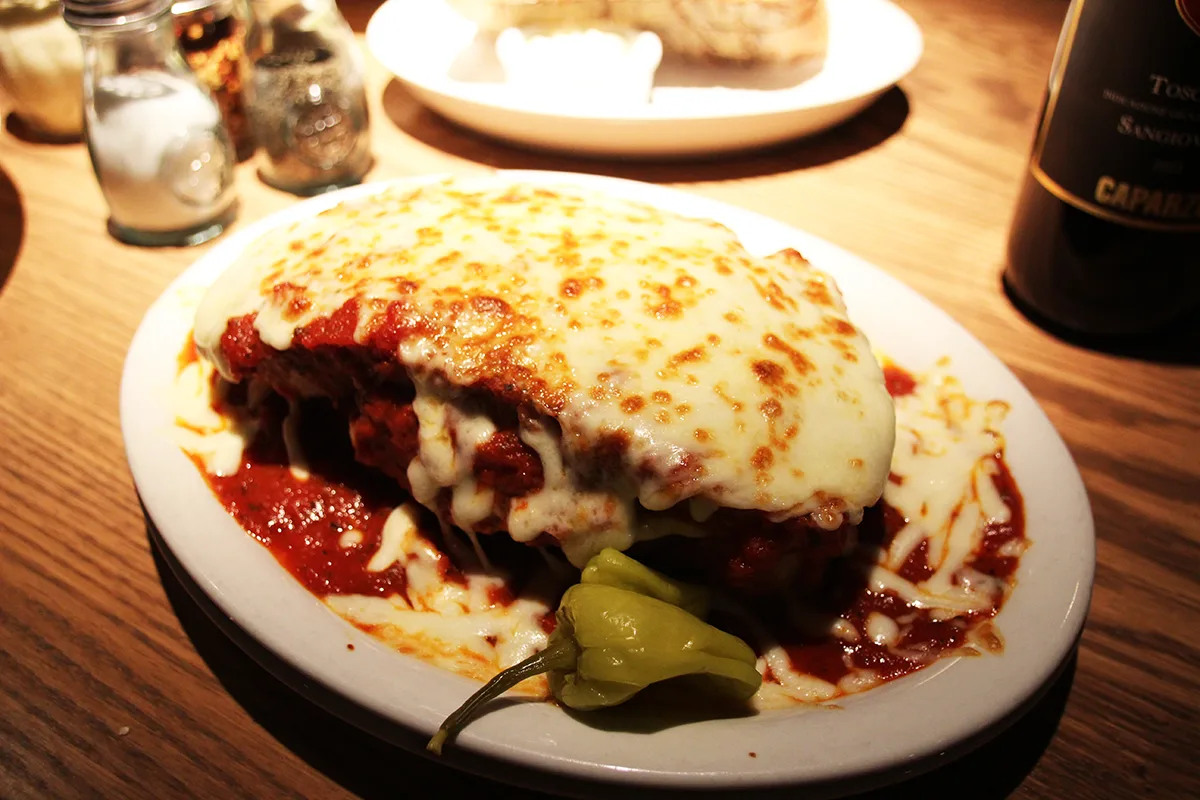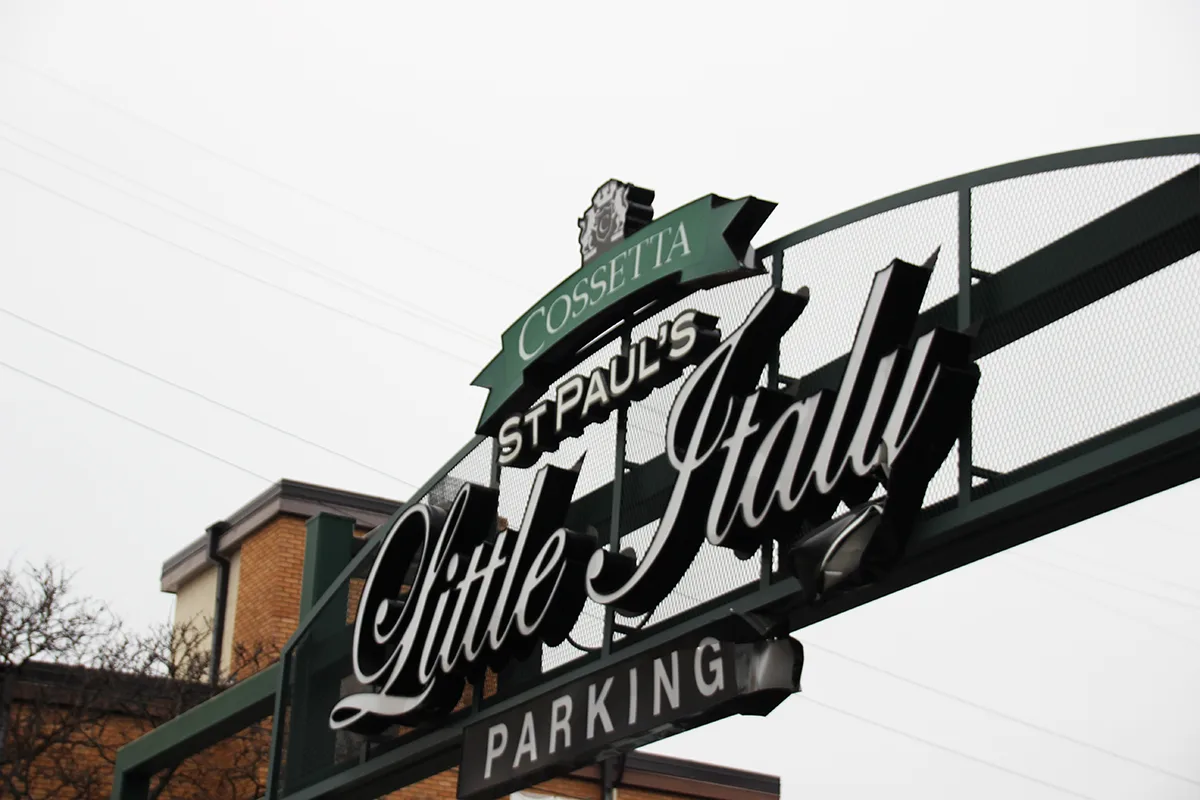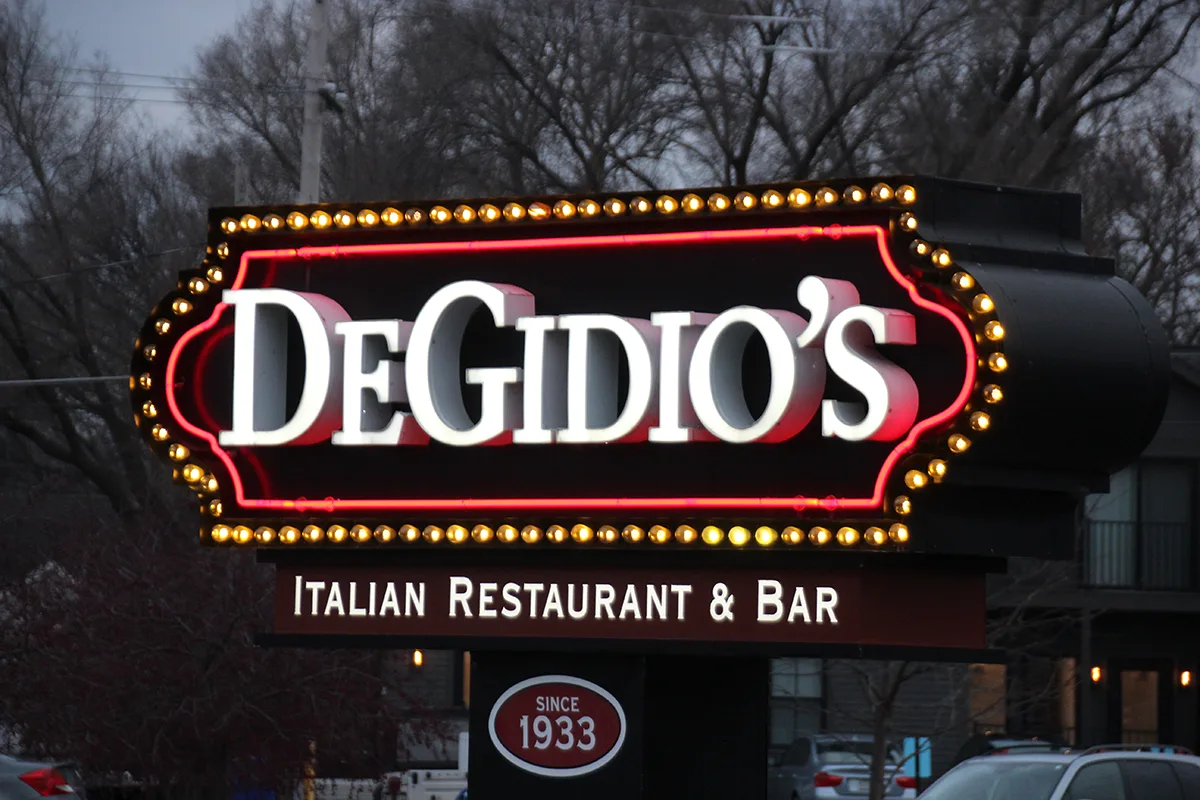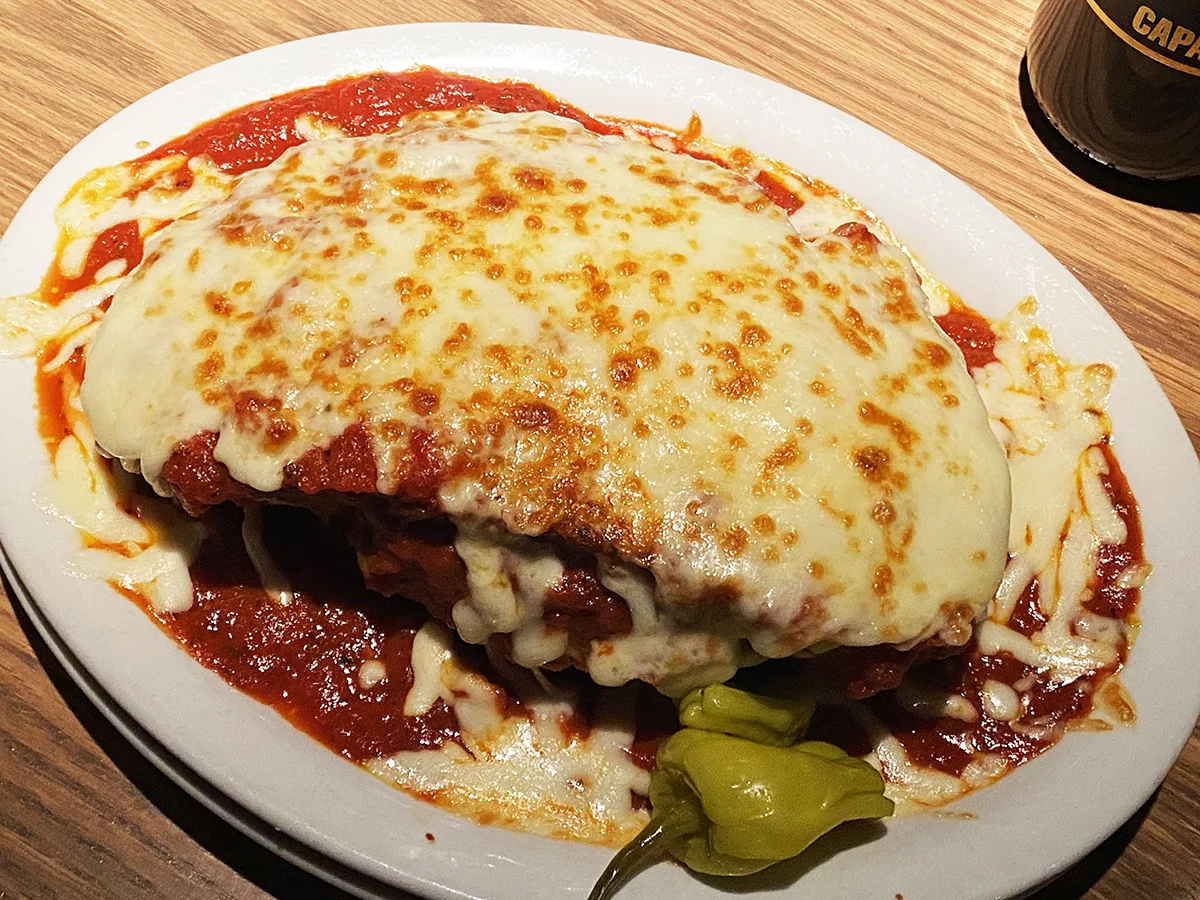The History of Minnesota’s Spicy Sausage Sandwich That’s Too Hot To Talk About
By Ian MacAllen on Friday, January 24th, 2025 at 8:19 pm | 1,822 views

Italians settling in the Twin Cities developed a unique sandwich with spicy sausage known today by a slur for people of Italian heritage. The sandwich, known as a “Hot Dago,” is a term more commonly thought of as a pejorative one, especially on the East Coast, but in Saint Paul, Minneapolis, locals insist, the term isn’t a slur at all.
What Is The “Hot Dago” Sandwich?
The “hot dago” today is a sandwich made from bread, a meatball or spicy sausage flattened into a patty, melted mozzarella cheese, and bathed in marinara sauce. The quintessential element is that the meat patty is fried in a pan and simmered in sauce.
There is some slight variation when it comes to bread. In some places, the sandwich is explicitly open-face, meaning there’s no top slice of bread. There’s also some debate whether the bread is American sandwich bread, Vienna Bread, Italian bread, or French baguette, with different restaurants using unique styles.
One of the most common versions of the sandwich is served smothered in the sauce the sandwich was cooked in. These sandwiches are better eaten with a knife and fork rather than hands. Imagine a sausage sandwich that has been parm’d like chicken cutlet or veal, topped with melted mozzarella cheese.
There are variations though. Eleven miles north of Saint Paul, just outside of Minneapolis, is Dusty’s Bar where the kitchen serves a “Dago” sandwich featuring a pork sausage patty. Here, the sandwich is more like a burger topped with mozzarella cheese, onions, and sweet peppers. This style of sandwich may actually be closer to the original “hot dago” invented in the early 20th century.
At Yarusso-Bros. Italian Restaurant in Saint Paul, they still serve their “hot dago” with a meatball-style patty, and rather than covering the sandwich with sauce, it usually comes on the side, used for dipping.
Finding the Sandwich in Minnesota
Minnesota isn’t at the top of the list as a destination for Italian immigrants. However, a sizable population nevertheless did settle in the area. Many came from around what is today Molise, although the city saw immigrants from across southern Italy. Minnesota’s Italian-born population peaked in 1910, at just under 10,000, and that was enough for a thriving Little Italy.

Today, Saint Paul’s Little Italy surrounds Cossetta, a marketplace with a grocery, bakery, pastry shop, and cafeteria area. The grocery section has plenty of Italian imports, plus midwestern Italian American favorites including Chicago-style giardiniera used to top Italian Beef sandwiches. The pastry shop has a selection of cookies, cakes, and sweets. Supposedly the whole shop was assembled in Italy, disassembled, and shipped to Minnesota where it was rebuilt in place. The cafe serves pizza, pasta, and hot sandwiches, including a “hot dago” named after the market.
Just a few blocks away down the street from Cossetta’s market is DeGidio’s, an Italian American restaurant known for red sauce favorites like lasagna and of course “hot dago” sandwiches. DeGuido’s opened in 1933, the year prohibition ended, as DeGiudo’s Royal Bar. There are rumors Joe DeGidio worked as bootlegger under the name “kid bullets,” but the Royal Bar had a decidedly more family-friendly tone. For a time, it was also a bowling alley.

John DeGidio took over the restaurant from his father in 1983, removed the bowling lanes, and set up a full service restaurant. After two decades, he passed the restaurant to two of his children who operate it today. The DeGido “Old Fashioned Hot Dago” is served with a side of banana pepper, but don’t be mistaken. The sausage itself is hot too, perhaps even, unexpectedly so for midwestern palates.
Yarusso Brothers, a family-owned Italian restaurant just outside Saint Paul’s downtown has also been operating since 1932 or 1933. Their menu includes up a “Dago Sandwich,” a beef patty simmered in sauce and served on Italian bread. Cheese is an optional extra. The “Dago Supreme” is a saucy sandwich with bell peppers, onions, and mushrooms.
The sandwich is also common at neighborhood pizzerias, the type of joints with paper menus that offer other Italian hot “hoagies.” The sandwich is primarily exclusive to Saint Paul, and even in Minneapolis, just a few miles away, is less common.
Who Invented the “Hot Dago”?
Most people seem to agree the “hot dago” sandwich came about during the era of prohibition, but finding any kind of documentation on the inventor is difficult. Many of the shops selling the sandwich are casual, family-operated businesses, and it’s rare these menus end up in archives.
Jason Tschida, a co-owner at DeGidio’s told Minnesota Monthly the sandwich has been around since at least the 1930s. But there isn’t much conclusion to draw from that.

I got in touch with Fred “Freddie” Yarusso of Yarusso-Bro, and he seemed to have some answers. He believes his grandfather, Francesco Yarusso, invented the very first “hot dago” sandwich. The earliest version of the sandwich was simply a flattened meatball served on a roll or Italian bread, according to Yarusso.
Cooking the meat in the sauce was also great for adding the flavor of the meatball patties to the sauce. It could then be used for pasta and other dishes. In part this is why the sandwich grew in popularity among home cooks.
The original sandwich was a meatball mix, but as time passed, evolved other variations made with all beef or hot sausage. Yarrusso’s still serves up a sandwich made with a meatball patty and the sauce can come on the side rather than smothering the sandwich. Dipping the sandwich into sauce makes it less like a “parm” and more like a French Dip, or in this case “Italian dip.”
Joe DeGidio and Francisco Yarusso may have been involved in the selling of alcohol during the period of Prohibition. For bootleggers who likely often kept odd hours and worked under the cover of night, the meatball patty sandwich offered a convenient way to have something to eat. When Prohibition ended, Joe DeGidio and Francisco Yarusso both opened taverns in Saint Paul. In addition to alcohol, the taverns also sold food, and the “hot dago” sandwiches made their way to the menus.
Other print references do appear after that period. In a 1942 issue the Post Office Supervisory Bulletin, a publication serving the National Association of Postal Supervisors, a meeting of local postmasters served a dinner of “Italian spaghetti with hot Dago sausage,” along with various other foods like Polish Sausage. It’s unclear if there is a reference to the Saint Paul-area sandwich or simply a slur indicating Italian Sausage.
Perhaps the first printed recipe comes from Volume II of the Pine to Prairie Cookbook, published in 1982 by the Telephone Pioneers of America. The Twin Cities Pioneer press published the recipe a few years back, and the patty mixture is a mix of pork sausage meat and ground beef – similar to a spicy meatball. More recent cookbooks and area guide books have also included recipes for versions of the sandwich, some calling it a “knife-and-fork” sandwich, as reference to the saucy bread.

A Hot Sandwich Name Under Fire
The sandwich name “hot dago” sounds like a slur to East Coast Italians, but at least in St. Paul, the locals claim it isn’t. But that hasn’t stopped some people from filing complaints.
The term “hot dago” has twice come under scrutiny as derogatory, and both times locals have rejected the claims its intended as a slur. The first time was in 1991. The former Saint Paul mayor Georgie Latimer had been recently named the dean of local Hamline Law School, and he invited his friend, Dominic Villoni, a lawyer from New York, to speak at the school. Over the course of the visit, Villoni learned of the sandwich popular in the city.
In New York City, the term was still very much a slur referring to Italian Americans, and Villoni was a member of a Queens, New York based organization representing Italian American lawyers. He raised the issue with the then human-rights director of the city, and according to the Pioneer Press, received an apology.
Sixteen years later, the director of the St. Paul Department of Human rights, W. H. Tyrone Terrill, also attempted to ban the term. Terrill issued a warning to DeGidio’s Restaurant, which had listed the sandwich on the menu and in advertising. Terrill objected to using the phrase in both circumstances. DeGuido’s lawyer responded by arguing the term referred to a sandwich – one that was well known in the city – and not to a person. The sandwich remains on the menu today.
That isn’t true of the menu at one area restaurant, Scratch Pizzeria, located in Eagan, Minnesota. The shop’s menu has on offer a “Hot ogaD,” inverting the name to avoid the connotation of a slur. Mama’s Pizza Parlor in St Paul, a restaurant operating for six decades, calls the sandwich a Hot Diego on their menu. And Cossetta’s cafe calls it “Our Famous Cossetta Sandwich.”
The racist phrase is much beloved by the locals with several writing into the local paper when Terrill raised the issue, with Bev Schwartz comparing it sauerkraut.
Despite the insistence of many Minnesotans that the phrase is benign, a local newspaper, the Morris Tribune, addressed the issue back in 1887, blaming Chicago. The writer explained the term dago was commonly applied to Italians, but often meant saloon and restaurant operators, and even back then the phrase was considered an “insulting epithet.” No explanation was given to the origin of the term beyond that, only that it was clearly Chicago’s fault.
Freddie Yarrusso told me the phrase has a different meaning altogether. It was a reference to working by the day, where people labor as the day goes by. The sandwich was great for day workers: inexpensive, easy to buy, and convenient. Either way, it’s a local sandwich and a local tradition. Don’t try to order one in Chicago, he warns, “They’ll think you’re nuts.”
Where To Eat It:
Yarusso-Bros. Italian Restaurant
Founded in 1932 or 1933, and serving a sandwich made with meatball mix.
635 Payne Ave, St Paul, MN 55130
Website
DeGidio’s
Founded in 1933, the sausage patty sandwich is served covered in sauce.
425 7th St W, St Paul, MN 55102
Website
Cossetta
A marketplace in “Little Italy,” Saint Paul, the shop renamed the sandwich after themselves.
211 7th St W, St Paul, MN 55102
Website
Scratch Pizzeria
Home of the more politically correct Hot ogaD.
3450 Pilot Knob Rd, Eagan, MN 55122
Website
Angelo’s Pizza
1203 Southview Blvd, South Saint Paul, MN 55075-2246
Website
The Italian Pie Shoppe
1670 Grand Ave, St Paul, MN 55105
Website
The Dog House
2029 Woodlynn Ave, St Paul, MN 55109
Website
Carbone’s Pizzeria
680 E 7th St, St Paul, MN 55106
Website
Dusty’s Bar
1319 Marshall St NE, Minneapolis, MN 55413
Website
Fireside Lounge Bar and Restaurant
1288 S Robert St, West St Paul, MN 55118
Website
Mama’s Place
961 Rice St, St Paul, MN 55117
Website

